Welcome to Impression’s Paid Search Industry Updates for August, where we uncover the latest PPC trends to help you stay ahead of the curve.
As usual, traffic light imagery is featured throughout to indicate the importance of each new update – red denoting a priority update, green representing a less important update and amber lying somewhere in the middle.
Keep reading to discover:
- Google introduces new lead form extensions to Google Ads
- Google launches a new audience report within Google Analytics 4
- Google Ads is saying goodbye to enhanced CPC on shopping campaigns
- Google has opened the beta to its new “Demand Gen” campaigns
- What is Demand Gen?
- What are the features of the new campaign?
- What's the timeline?
Google introduces new lead form extensions to Google Ads

Following Google’s introduction of lead form extensions back in 2019, it was announced this month that Google will be fully integrating this within all of its campaign types.
Lead forms help generate leads by letting people submit their information in a form directly from your ad. This can be generated in your current Google Ads account, and attached to your desired campaign. So when your audience interacts with your ad that contains your ad asset, they are prompted to input their information in the form instead of being directed to your company website.
Currently, lead form assets are available on Search, Display and Discovery ad types and can work in different ways depending on that particular campaign type. For example on Search, lead forms can appear on both mobile and desktop devices. Whilst for Discovery, 1 image ad is required in order for lead forms to serve given they are not compatible with carousel ads. Meanwhile, for Display, lead forms can appear on both mobile and desktop devices, followed by at least 1 responsive display ad.
What does this mean for me?
For advertisers, this will mostly benefit B2B clients or any other business that is looking to generate leads. Additionally, if your company does not have the resources (time, expertise, money) to improve the web experience, lead form assets are a great way to gain first-party data given their simplicity to set up, leading to better campaign management as well as its ability to download leads directly from Google Ads.
However, advertisers need to be cautious as traffic does not necessarily lead to your website given users are required to input information in a lead form rather than through the website. Furthermore, lead forms are only available in certain countries. This means that if an ad is served to an audience in an ineligible country, they will not be able to view the lead form.
Following this, a minimum of more than $50K must be spent over a lifetime in order for your ad account to qualify. Other requirements include having a good history with Google’s compliance policy, belonging to an eligible vertical or sub-vertical as well as having a privacy policy for the business. Also, given lead form assets work differently for each campaign type, it can be difficult to understand the criteria needed for each, making attribution harder.
Google launches a new audience report within Google Analytics 4

With the recent rollout of Google Analytics 4 last month, Google launched a new Audience Report within its interface, helping advertisers identify their most engaged and profitable audiences, including any audience that has at least one user in a specified time period.
The report can be found under ‘User Attributes’, located on the left-hand side of ‘Reports’.
To view, follow these simple steps;
- Sign into your Google Analytics account
- Select the ‘Reports’ button on the menu located on the left-hand side
- Select ‘User’, then scroll down to ‘User Attributes’
- Click ‘Audiences’
If you cannot see the report, ask an administrator or editor to add the report through the report library.
The new Audience Report will include the following metrics and dimensions – which can be added or removed by the editor or administrator.
Metrics
- Active users
- Average Session Duration
- New Users
- Sessions
- Views Per Session
- Total revenue
Dimensions
- Audiences
What does this mean for me?
For advertisers, this will provide a better insight into who their target audience is, as you’ll be able to understand who is engaging most with your campaigns and websites. Equally, you can then use this data to make more informed decisions on your marketing campaigns, helping to increase your volume of conversions and return on investments and ultimately your campaign performance.
Google Ads is saying goodbye to enhanced CPC on shopping campaigns

In the past couple of days, advertisers are being sent out information from Google, about how shopping campaigns, will no longer use “Enhanced CPC” as a bidding strategy from October 2023
Why Are Google Making This Change
In summary, the reason that Google has stated they are making this change is that firstly, the old ECPC bidding structure has been around for 10 years now and in that time following the launch, Google has implemented more advanced bidding strategies, that “help you achieve better results”, it is for this reason that Google, feels that the strategy has become outdated and Google is pushing advertisers to move strategy.
What does this mean for me?
Well, don’t worry, there are options for your campaigns!
Firstly, if you’d like to remain on a fairly similar (to an extent) bidding strategy, then the campaigns will automatically switch its strategy to “Manual CPC”.
However, this could be a great time to re-evaluate your strategy and switch to a more “modern” bidding strategy, such as Maximise Conversions (Target ROAS) for example, something which Google is also pushing advertisers down, is through experiments, which could be a good way to showcase a change before fully committing to a new bidding strategy.
Google has opened the beta to its new “Demand Gen” campaigns

The new campaign type was initially introduced by Google back in May. It was announced by Google this month that advertisers can sign up for the beta, getting you access to the new campaign type.
Once you have therefore enrolled in the beta, your campaign will then be automatically updated to Demand Gen. Starting from October, Discovery ads will be eligible for an upgrade to Demand Gen.
What is Demand Gen?
Google has introduced this new “AI” powered campaign, as a way of multiplying your creativity and driving demand. The campaign has been designed to help advertisers who “buy on social platforms find and convert consumers with immersive, relevant, and visual creatives that grab attention and spur action in the right moment.”
The new campaign works with conversions, site visits and other conversion actions including; Sign Ups for example, within Google’s entertainment touchpoint Youtube, therefore including shorts, discover and Gmail.
Below, is a handy graphic from Google, about the new Demand Gen features, which come with the new campaign type.
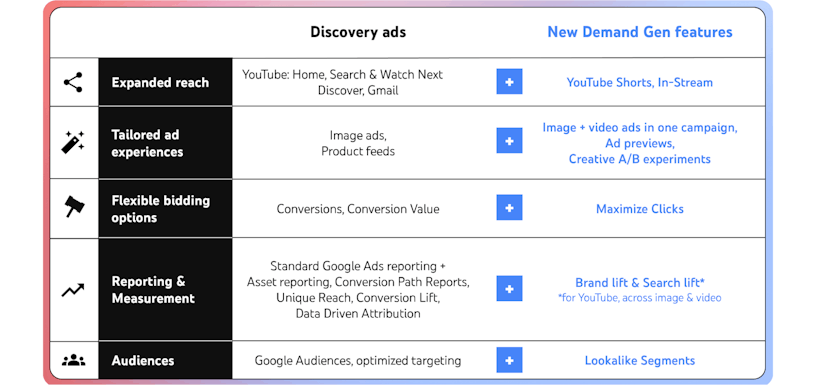
What are the features of the new campaign?
- Engaging Audiences With A Variety Of Ad Formats
Similarly to how Performance Max is structured, within this new campaign type, we can utilise, video and images in one single campaign.
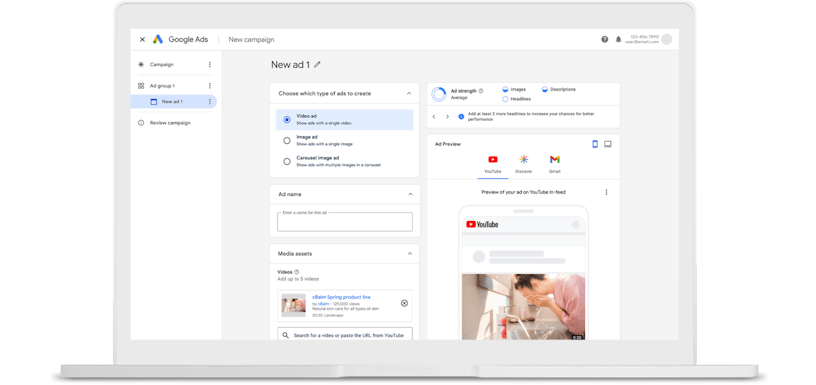
- Lookalike Segments
Within this campaign, you can upload your first-party data and Google will match this data alongside its audience and interest signals, helping you find new customers, similar to those who have converted before. A feature that has been seen with Facebook Ads.
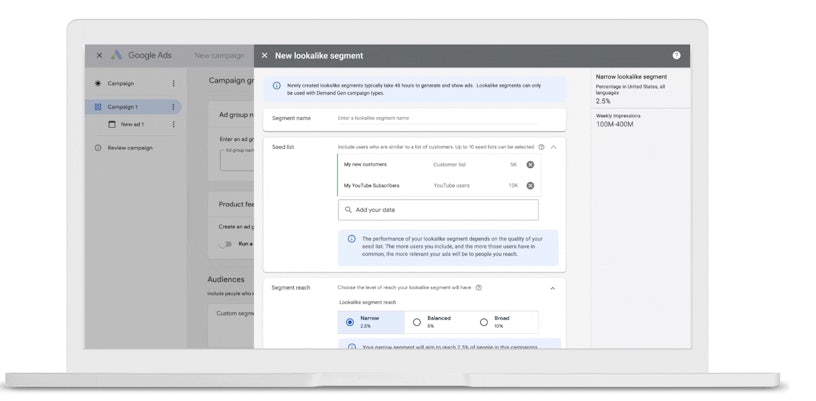
- Unique Goals
You can optimise your campaigns towards conversions or you can use value bidding strategies.
- Ad Previews
View your new creatives, within Google’s new improved Ad preview workflow.
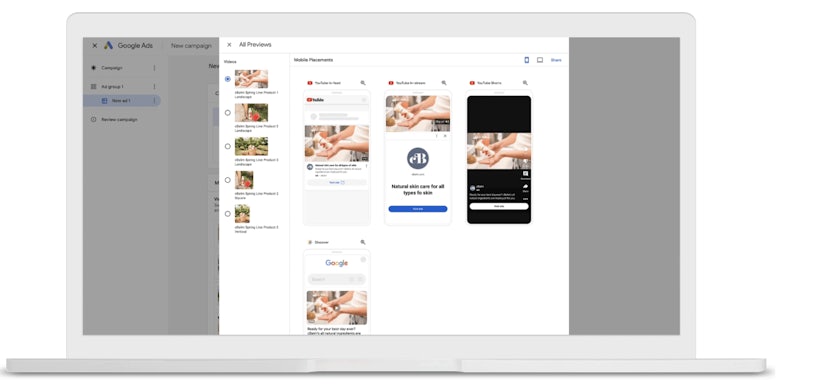
What’s the timeline?
The beta is open now for anyone wanting to get started with the campaign, before the full upgrade begins during the latter part of 2023 into 2024, with all accounts being fully upgraded from January to March of 2024.
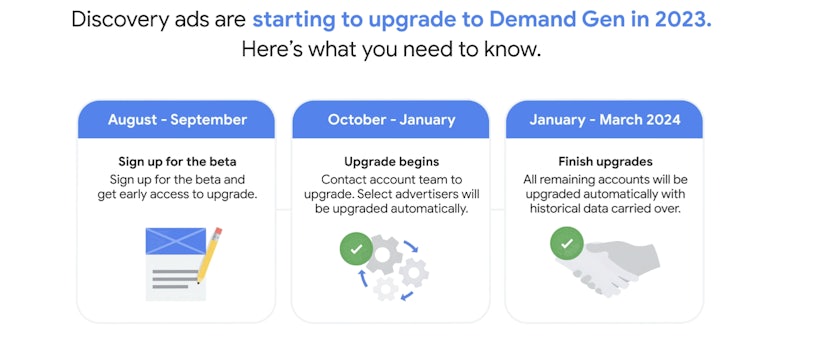
What does this mean for me?
If you currently run discovery campaigns, now could be a perfect time to get ahead of the pack and sign up for the beta to try out the new campaign type. However, as with any beta, there will be changes made to the campaign between now and October. There are many new features within this new campaign type and additions like this are very welcomed!
Look out for our next blog in September for more paid search industry updates to inspire your PPC strategy. If you want to talk about your business aspirations, get in touch!



